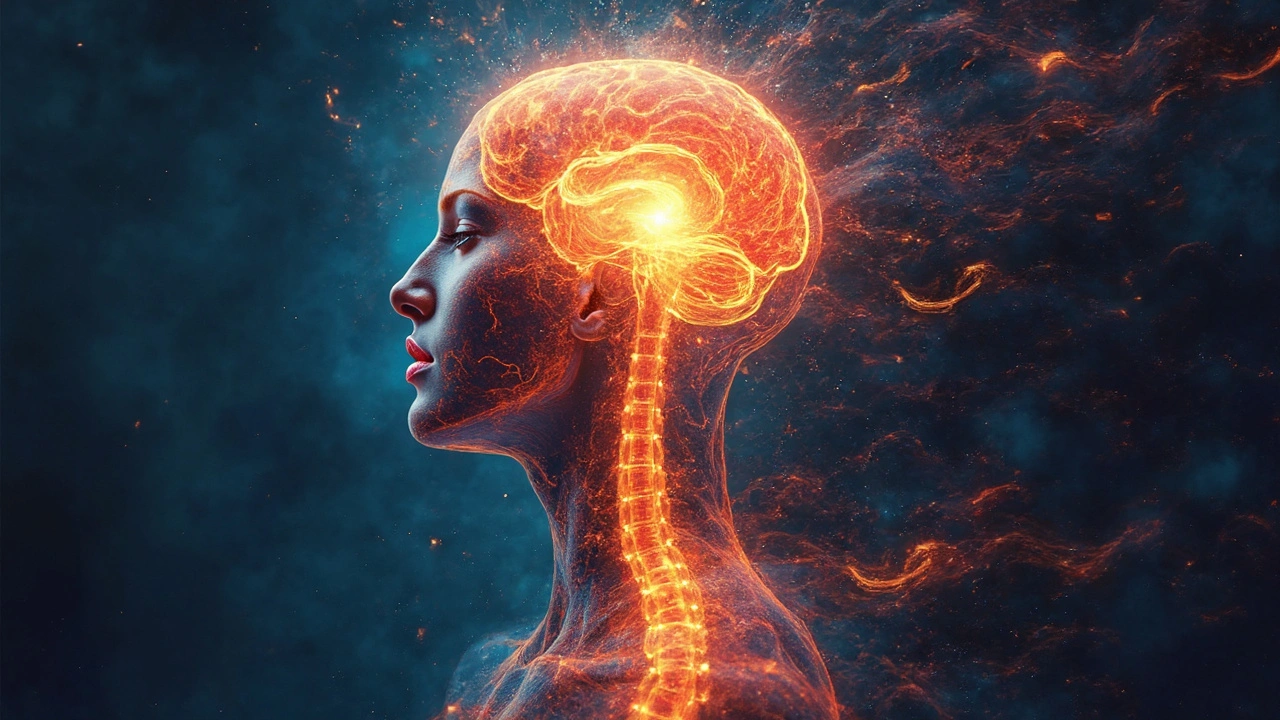Craniosacral Therapy (CST) might sound like a fancy term, but it’s quite straightforward once you get the hang of it. CST is all about using a light touch to help your body sort itself out. But how does it work, and what should you know before considering it?
First off, CST focuses on gently touching areas around the head, neck, and spine. The idea is to improve the flow of cerebrospinal fluid, which some folks believe can enhance the body's ability to heal itself. It's a bit like giving a gentle nudge to your body's internal rhythms, encouraging things to flow better.
For those new to it, it might seem a bit like magic. But practitioners are actually trained to 'listen' with their hands for subtle changes in craniosacral rhythm. This isn’t about bones cracking or manipulations; it’s more about being in tune with your body.
Potential benefits are said to range from stress relief to reducing pain. People report different experiences, but the common thread is the sense of relaxation and well-being.
If you're considering trying CST, find a reputable therapist and go in with an open mind. Who knows, it might just be the gentle touch your body craves.
- The Basics of Craniosacral Therapy
- How Craniosacral Therapy Works
- Potential Benefits
- Common Misconceptions
- Tips for Trying Craniosacral Therapy
The Basics of Craniosacral Therapy
So, what's the deal with craniosacral therapy? Let's break it down to the nuts and bolts. At its core, CST is a gentle, non-invasive therapy that taps into the body's natural healing abilities. Think of it like giving your body a gentle, guided reboot.
It all starts with the craniosacral system, which includes the membranes and fluid surrounding your brain and spinal cord. The primary goal here is to ensure everything flows smoothly — kind of like making sure there's no traffic jam in your nerve city.
How It All Began
Craniosacral therapy sprang from the work of osteopath William Sutherland, who back in the early 20th century, had this quirky idea that the bones in our skulls are designed to move. Seems odd, right? But, his theory evolved, and CST became part of the broader holistic healing landscape.
What Happens During a Session?
If you step into a CST session, don't expect dramatic movements or cracking. A practitioner usually has you lie down comfortably and places their hands lightly on your head, neck, or back. The idea is to 'listen' to the craniosacral rhythm, and trust me, it's way more calming than it sounds.
Who's It For?
People looking into CST might be dealing with stress, pain, or simply be curious about improving their wellness. It's often sought by those who want a mellow, yet potentially effective way to tap into their body's healing vibes.
Some Basics to Keep in Mind
- It's non-invasive and safe for most people.
- Sessions typically run about an hour or so.
- It emphasizes a gentle touch, so it's more soothing than jarring.
- It's used for a wide range of issues — from migraines to stress relief.
Remember, like any therapy, results can vary. If you're intrigued, give it a shot and see how your body responds! Who knows, it could be the wellness hack you've been looking for.
How Craniosacral Therapy Works
At its core, craniosacral therapy is about tuning into your body’s natural rhythms. But how does a therapist actually do that? It all starts with a gentle touch, usually no heavier than the weight of a nickel, which is applied to various areas around the head, spine, and pelvis.
Listening to the Body’s Rhythms
Trained practitioners believe that every person has a unique craniosacral rhythm, like a heartbeat, but subtler. By placing their hands lightly on your body, they try to feel this rhythm and identify any disruptions or blockages. It’s almost like a conductor listening for an out-of-sync instrument in an orchestra.
Releasing Tension
This is where the magic happens—or at least the science. The therapist aims to release any tension that might be affecting the flow of the cerebrospinal fluid, which surrounds and cushions your brain and spinal cord. By gently guiding your body back to its ideal rhythm, the therapy hopes to reduce stress and promote healing.
Here's an interesting tidbit: some researchers have found early evidence suggesting that craniosacral techniques might help improve the functioning of the autonomic nervous system. This could mean better overall health and resilience against stress.
Benefits and Sensations
Many people find the practice deeply relaxing. You might feel a warm sensation or a gentle unwinding, as if your body is releasing built-up tension. These sensations, while subtle, are part of the therapeutic process loosening your body’s internal structures.
While CST isn’t a cure-all, some have reported benefits for a variety of conditions, ranging from migraines to chronic pain and PTSD. Each session is unique and catered to the individual's needs, making it a personalized approach to health and wellness.

Potential Benefits
So, what's the buzz about craniosacral therapy when it comes to benefits? While research is still ongoing, many people who have tried CST swear by its ability to bring about a sense of calm and improve overall well-being. Let's break down some of the reported benefits.
Stress Relief and Relaxation
One of the most talked-about advantages is stress relief. By gently helping the body release tension, CST can lead to a significant reduction in stress levels. People often walk away from a session feeling as though a weight has been lifted off their shoulders.
Pain Reduction
Some folks use craniosacral therapy to help manage chronic pain. There's anecdotal evidence suggesting that CST can decrease pain associated with various conditions, from migraines to neck aches. The key here is the gentle touch, which avoids aggravating any pain points.
Enhanced Sleep Quality
If you're tossing and turning at night, CST might just be the ticket to better sleep. Many people report improved sleep patterns after a session or two, attributing it to the overall relaxation and balancing effect CST provides. A solid snooze can do wonders for your energy levels and mood.
Emotional Balance
Some say CST works wonders for emotional health. By helping to balance the central nervous system, this therapy might contribute to emotional stability and well-being. It's like hitting the reset button on your mood, helping you manage emotional challenges with more clarity.
Immune System Support
While it might not be a cure-all, proponents of CST believe that by optimizing the flow of cerebrospinal fluid, the body’s internal healing mechanism gets a boost. A few practitioners suggest that this can help keep your immune system in tip-top shape.
Ultimately, while craniosacral therapy can offer numerous benefits, the experience can be unique for each person. If you're curious about trying it, just remember to tap into the expertise of a qualified therapist to guide you through the process.
Common Misconceptions
There are a few things that people get wrong about craniosacral therapy, mostly because it sounds mysterious. First, folks often think it's some kind of deep tissue massage or a bone-cracking session like chiropractic methods. In reality, it’s much gentler.
Misunderstanding the Touch
One of the biggest misconceptions is about the touch itself. People might expect to feel a lot of pressure or vigorous movements, but that’s not the case. During a session, the therapist uses such light touch that it's sometimes described as feeling like a weighted blanket. This gentle approach is intentional, designed to let the body’s natural rhythms shine through.
CST as a Cure-All
Another big myth is that craniosacral therapy can cure any ailment. While it’s true that many experience relief from things like stress and tension, it’s not a guaranteed fix for everything. According to Dr. John Upledger, who popularized CST, the goal is to support the body and its natural healing processes.
"CST is intended to facilitate the body’s natural and innate ability to self-correct," he once explained.
The Science Debate
Some critics argue there’s not enough scientific evidence to support all the claims made by advocates. It's definitely an area where research is ongoing, and results can be subjective. People who benefit from it often describe feeling more relaxed and balanced, but it's good to approach it with realistic expectations.
Table: Understanding Perceptions
| Myth | Fact |
|---|---|
| Heavy Pressure Used | Light, gentle touch |
| CST Cures All | Supports natural healing |
| Backed by Extensive Science | Research is ongoing |
So, if someone tells you that craniosacral therapy involves cracking heads or promises to cure your allergies overnight, you can nod politely but know that it’s not quite that simple. The best way to understand is by experiencing it for yourself, keeping in mind its subtle, supportive nature.

Tips for Trying Craniosacral Therapy
So, you’re thinking about giving craniosacral therapy a shot? Great choice! But before you dive in, here are some handy tips to make sure you get the most out of the experience.
Do Your Homework
First things first, research is key. Not every CST practitioner is created equal, so take some time to find someone who is well-trained and comes with glowing recommendations. Check for credentials and look for reviews or testimonials from previous clients.
Set Realistic Expectations
Going in, it's important to have realistic ideas. Craniosacral therapy is not a miracle cure, but many find it beneficial for promoting relaxation and a sense of well-being. Don’t expect instant miracles, but open up to the possibility of subtle improvements.
Communicate with Your Therapist
Before your session, have a chat with your practitioner. Let them know about any specific issues or areas of discomfort. Good communication can help tailor the therapy to your needs.
What to Wear
Comfort is king. Wear loose, comfortable clothing to your session. You won’t need to change into specific gear, but just ensure you're at ease.
Give it Time
Therapy sessions often take about an hour, and results might not be immediate. Allow yourself some time to relax after the session; maybe plan for a chilled-out evening.
Consider the Cost
Cost can vary significantly depending on where you live and the credentials of the therapist. Check prices beforehand and see if your health insurance covers it. Here’s a helpful range to give you an idea:
| Location | Average Cost per Session |
|---|---|
| Urban Areas | $80 - $120 |
| Suburban Areas | $60 - $90 |
Craniosacral therapy offers an interesting avenue for those interested in alternative methods of well-being. With a bit of prep and an open mind, it might just be what you're looking for!

